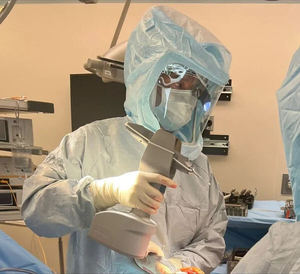July 11, 2006
Originally Published MPMN July 2006
INDUSTRY NEWS
University Researchers Create Artificial Compound Eyes
|
A magnified image of an artificial compound eye shows some of the 8700 hexagonal microlenses that make up its surface. Photo courtesy of Science Magazine/Luke Lee. |
Artificial compound eyes that can be converted into cameras may have medical applications. A team of bioengineers at the University of California, Berkeley (www.berkeley.edu) has created a series of artificial compound eyes using the eyes of insects, such as dragonflies and houseflies, as models.
The eyes can eventually be used as cameras or sensory detectors to capture information from a wider field of vision than previously possible. Potential applications include medical procedures that require cameras, such as endoscopies and image-guided surgeries, and a number of clinical treatments that can be controlled by implanted light-delivery devices. The eyes are described in the April 28, 2006, issue of the journal Science.
The eyes are the first three-dimensional, hemispherical optical systems to integrate microlens arrays with light-conducting channels. Thousands of tiny lenses are packed side by side in the artificial eyes. "I've always wanted to create a three-dimensional optical system, but conventional microfabrication technology is two-dimensional," says Luke P. Lee, the team's principal investigator. As a result, he decided to base a fabrication system on the developmental stages of insect eyes.
Lee and his team came up with a low-cost, easy-to-replicate method of creating pinhead-sized polymer resin domes. The domes are spiked with thousands of light-guiding channels, each topped with its own lens. The units are packed together in the same hexagonal, honeycomb pattern as in an insect's eye. Each dome is also similar in size, design, shape, and function to an ommatidium, the individual sensory unit of a compound eye.
Just like a dragonfly's eye, the team's artificial ommatidia are each oriented at a slightly different angle. The lenses and waveguides of the artificial eyes focus and conduct light in the same way as an insect's eye. An insect's ommatidia each ends in a photoreceptor cell that transmits a light signal to the creature's optic nerve. To replicate this trait, the researchers will pair the artificial eyes' ommatidia with CCD photodiodes, the light-capturing units used in digital cameras and camcorders. There is also a plan to link them to spectroscopes for chemical detection and analysis. "The lenses and waveguides are the most important part of the system," Lee says. "Now that we've created them with an angle, we're ready to integrate imaging or chemical sensing into the eyes."
To create the artificial eye, the team constructed a hemispherical mold of the eye's outer layer, a structure consisting of thousands of microlenses. Using existing technology, they made a flat array of the tiny, domed lenses arranged in the honeycomb pattern. On top of this, they applied a thin slab of polydimethylsiloxane (PDMS), an elastomer, creating a concave pattern of the lenses. By affixing the PDMS membrane over the opening of a vacuum chamber and applying negative air pressure, they pulled it into the dome shapes they needed. Different pressures were used to control the form. The result was a compound-eye mold pocked with some 8700 indentations that can be used over and over again using soft lithography technology.
An epoxy resin was used to make the mold. The researchers poured the resin into the dimpled mold, baked it at a low temperature, then turned out the contents: little resin hemispheres with a surface packed with 8700 raised mounds. When struck by a beam of light, each of these mounds acts as a lens, focusing the light and sending it into the material below. Over time, the focused light beams etch holes in the resin, creating the tiny channels known as self-written waveguides.
The waveguides are formed at the angle of the light beams that strike them. Lee used a condenser lens to bend the light source into a spoke-like pattern of beams that converges on the eye's dome. As a result, the waveguides pierce the resin at angles that head toward the center of the dome, just like the pattern of converging ommatidia in an insect eye. Because the microlenses create the waveguides, each microlens is perfectly aligned with its waveguide. The self-aligned self-writing process is crucial to the creation of the artificial compound eyes, because this process will also align the microlenses and waveguides with the pixels of CCDs and spectroscopes.
Copyright ©2006 Medical Product Manufacturing News
You May Also Like



